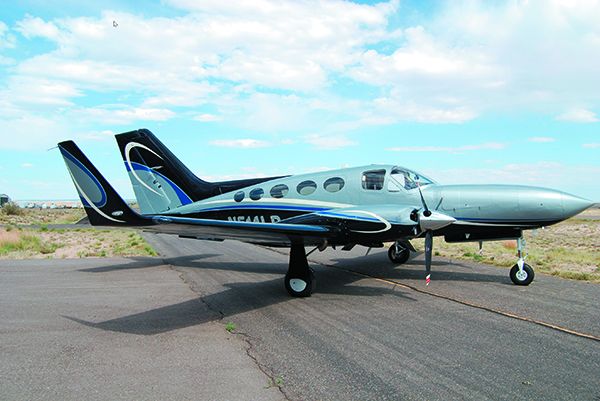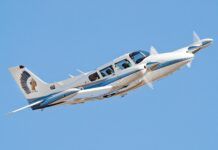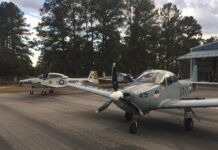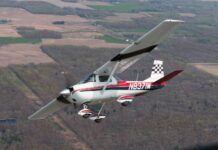The Cessna 414 may not be the ultimate piston twin, and like others in its class, there are compromises. Combining spacious pressurized cabins and relatively small, efficient engines, the 414 series can carry lots of fuel or a small crowd with their belongings—but not both.
All told, Cessna built nearly 1000 of the airplanes—roughly a 50/50 split between early tip-tanked 414s and wet-wing 414A Chancellors—during 16 years of production. What helped sell the airplane in the beginning still applies today because once in service, the 414 series airplanes became popular as workhorses for small charter and corporate flight departments, as well as comfortable transports for private owners.
The earliest 414s may seem bargain priced at typical retail prices around $120,000, while late-model, upgraded birds from 1985 are well north of $350,000. But like any airplane in this category, good maintenance will be a big nut to crack.
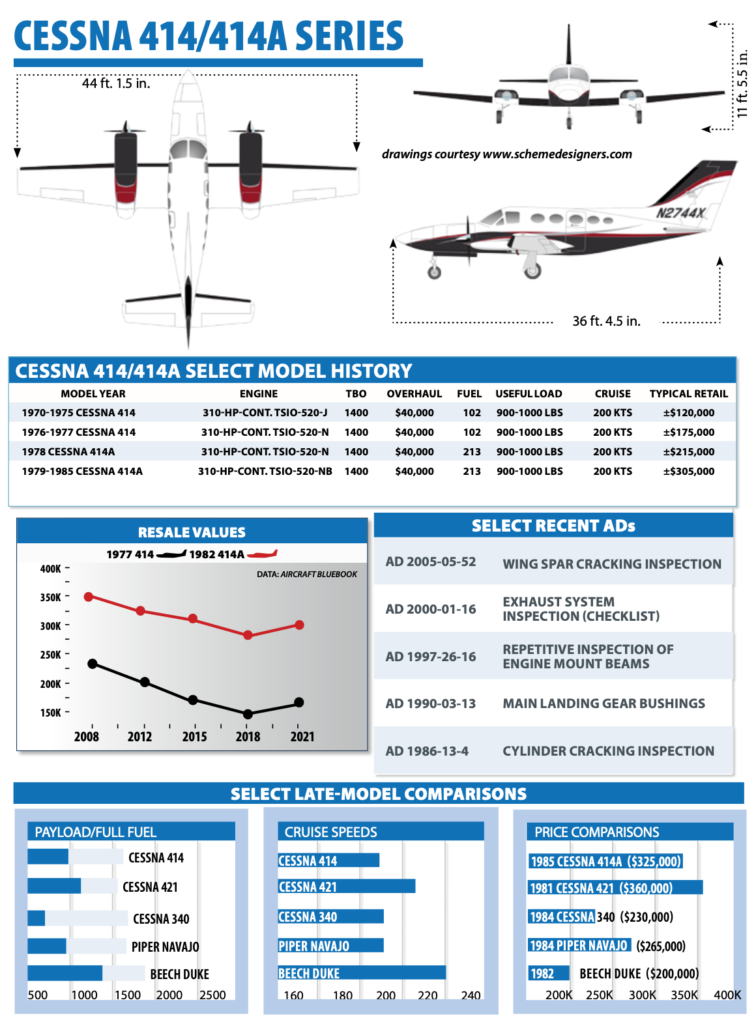
MODEL HISTORY
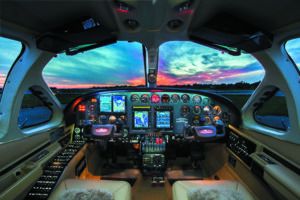
You don’t have to look at the airplane for long to see that Cessna borrowed major components from other 400-series twins when building the 414. Turns out that wasn’t a bad idea, but we often wonder if the market really needed the 414. It had basically the same tail and “wide-oval” fuselage as the 421B, and the 401’s wing. The engines were adapted from those used on the 401 and 402 models—the differences were intercoolers and provisions for bleed-air cabin pressurization.
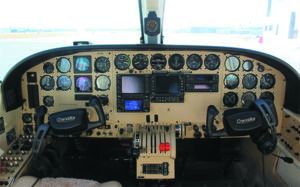
The list price of a typically equipped factory-new 414 in 1970 was $190,902—and that’s roughly $1.3 million in 2021 dollars. At the time, the 414 was $35,000 less than the Beechcraft’s pressurized Duke and some $50,000 less than both Cessna’s own 421 and Piper’s P-Navajo.
The original engines were 310-HP Continental TSIO-520-J’s, and propellers were three-blade McCauleys. According to Cessna, 4.2-PSI cabin pressure differential could be maintained by either engine operating at 60 percent power. Six seats were standard; a seventh was available as an option. Maximum takeoff weight was 6350 pounds; max landing, 6200 pounds.
In the years following its introduction, the airplane saw few major changes. One of the most important came in 1973, when cabin length was increased 16 inches and a fifth side window was installed. Electronic prop synchrophasers became standard equipment in 1976, when two versions of the airplane were put on the market: a bare-bones 414 and a 414II, which came with an assortment of ARC 400-series avionics equipment.
That year, most limiting and recommended airspeeds were boosted a few knots (except Vmc, which was lowered from 84 to 82 knots), and the -J engines were replaced with TSIO-520-N’s. The difference is that an -N engine uses 38 inches of manifold pressure, rather than 36 inches, and 2700 RPM to produce its rated 310 horsepower. Standard usable fuel capacity of early 414s was 100 gallons (50 in each tip tank). Optional auxiliary and locker tanks were available to boost usable capacity to 180 gallons, then to 203 gallons in 1973.
An important part about learning to fly Cessna 400-series twins is managing the fuel. The fuel system in early 414s is complex, especially with wing locker tanks installed, and proper fuel management requires attention to detail. There are only two fuel-quantity indicators, both with three-position switches, to help the pilot keep track. The drill is to run the engines off the mains (which are the tip tanks) for 90 minutes before switching to the auxiliary tanks.
This makes room in the mains because all return fuel and vapor from the engines is routed back to the mains rather than to the tank selected. To get at the fuel in the wing locker tanks, it must first be transferred to the mains. Before doing so, however, the pilot has to ensure there are fewer than 20 gallons in each main (tip) tank. Fuel transferred too early is pumped overboard. The system left room for error, not only on the part of the pilot, but among line personnel fueling the plane.
It pays to supervise the fueling because when told to “top off the mains,” a line person may not realize that the mains are the tip tanks and will fuel only the aux tanks. We’ll say it again: Pay attention to the fuel system in tip-tanked 414s, and understand how it works. But it got better as the model line matured.
A simpler fuel system was among a host of improvements unveiled in 1978 with introduction of the Model 414A Chancellor. Tip, aux and locker tanks were obviated by a 4.5-foot longer, bonded wing holding 206 gallons of usable fuel in internal bays. Controls consisted of on/off/crossfeed valves and a fuel flow computer/indicator was added.
The wing changed, too. A 30-square-foot increase in wing area accommodated a 400-pound increase in maximum takeoff weight and a 550-pound increase in landing weight. A ramp weight of 6785 pounds was approved to allow for the consumption of six gallons of fuel during start, taxi and runup. Also, a zero-fuel weight of 6515 pounds was published to preclude excessive wing bending loads.
The 421’s longer nose also was grafted onto the 414A, making space for an extra 410 pounds of baggage and remotely mounted avionics. All told, maximum useful load was boosted about 200 pounds and an eighth seat was added to the options list. Pressurization differential was increased to 5.0 PSI to enable the airplane to maintain cabin altitudes of 10,000 and 11,950 feet at cruising altitudes of 26,500 and 30,000 feet, respectively, although RVSM rules have generally limited 414s to 28,000 feet. Limiting speed for the extension of 15 degrees of flap was raised from 164 to 177 knots; Vlo and Vle were increased to an impressive 177 knots, from 143 knots.
Beginning in 1978, Cessna offered three basic equipment packages. In addition to the bare-bones model and the ARC 400-equipped 414AII, there was a III version with ARC 800- and 1000-series avionics, a Bendix RDR 160 weather radar and 100-amp alternators.
On a side note, while many 414s have updated avionics, some still sport original radars, autopilots and round-gauge flight instruments. Pay close attention to the performance of these systems during the pre-buy process. Whether it’s an original Sperry/ARC autopilot or King KFC200, it’s worth it to have a shop go through the maintenance records to make sure it’s been periodically maintained. And when you fly it on the demo run, be certain to engage the autopilot and observe how it flies enroute and on approaches. Also have the radar evaluated. These are big-dollar items that can bring big and unplanned invoices for repair.
After the Chancellor debuted, there were few further refinements. One of the most important was the switch in 1979 to TSIO-520-NB engines, which have improved crankshafts. Four years later, Continental incorporated some changes to the -NB’s cylinders, valve lifters and piston pins, and increased the engine’s recommended TBO from 1400 to 1600 hours. Continental also published overhaul procedures to enable -NB engines to get the TBO boost.
Despite that, cylinder head cracking has been a persistent problem for the -N and -NB engines (as well as for other IO-, TSIO- and GTSIO-520s). An AD issued in 1986 requires cylinders to be pressure-checked for leaks every 50 hours until the engine has amassed 500 hours.
Four different pressurization systems were offered during the run of the 414A, so it’s essential that the maintenance technician working on a pressurization glitch confirm which system by aircraft serial number.
PERFORMANCE/ CABIN LOADING
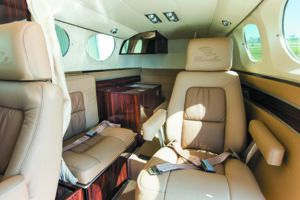
You could take a 414 up to 30,000 feet, but most pilots generally operate them in the upper teens and lower 20s. Expect to see speeds in the 190-knot range, burning 32 to 34 GPH at 65 percent power. You can crack 200-plus knots (205, generally) at 38 GPH at 75 percent power rich of peak EGT, although few operate that way anymore. With GAMIjectors and lean-of-peak operation, pilots report a reduction of about 3 GPH per engine at all power settings, as well as cooler operating temperatures.
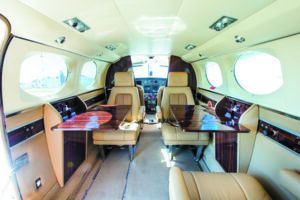
Single-engine performance at sea level is average, about 240 FPM for the 414 and 290 FPM for the A model. At 11,350 feet, the 414’s single-engine service ceiling is below average, but, at 19,850, the 414A is tops in its class.
Like most all twin Cessnas, we give the 414 high marks for cockpit ergos, and the logical layout of systems and controls makes the flight deck a comfortable place to chew up the miles. Handling is good, too.
The 414 and 414A share the distinctive silky-smooth control response of the other 400-series Cessnas. The 400-series Cessna twins have earned a reputation as the Cadillacs of the piston line, with attention having been paid to detail; even on an airplane of this vintage, only slight trim changes are needed when flaps or landing gear are reconfigured, although single-engine handling, as with any piston twin, is demanding and requires regular practice. There’s a reason why insurance companies have favored quality simulator training. Like all Cessna twins, this is not an airplane to fly without real training.
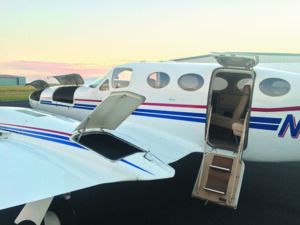
It is, however, a decent passenger’s airplane. The big cabin (wider than it is tall) makes for comfortable seating and copious baggage space—the 414’s forte. There’s enough room in the aft cabin, the nose and wing lockers of a 414 to hold 930 pounds of baggage. With its bigger nose and lockers, the 414A can carry 1500 pounds. Loading must be watched carefully to avoid going out of the rear CG limit. The nose baggage compartment of the 414A made CG juggling easier.
This isn’t a long-hauler for a lot of people, stuff and a lot of fuel. With full tanks—enough fuel for nearly 4.5 hours with IFR reserves—a well-equipped Chancellor will have room left in its weight-and-balance envelope to accommodate six FAA-standard people with their toothbrushes. Load a six-person corporate staff with 800 pounds of demo equipment headed to a trade show, and there will be room left for only about 1.5 hours of fuel. As we said in the opener, there are compromises and for some missions, perhaps better choices.
For example, it’s worth mentioning that a 414 is 7 knots slower than its little brother, the 340, which has the same engines and many of the same systems, but a notably smaller cabin. So, if it’s just pressurization you’re looking for and you’re going to be flying with only another person or two aboard, you might want to look at the 340—a machine we consider to be a personal hot rod.
However, a 414 appears to be a good choice for anyone who wants a pressurized airplane with a big cabin and lots of baggage space. Compared to its biggest competitors—the 421 and Duke—a 414 provides more room than the Duke, as much as the 421, travels a little more slowly, but does so more economically.
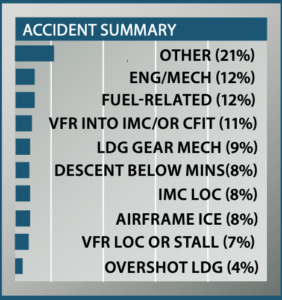
We had to go back more than 30 years to find the 100 most recent accidents involving the Cessna 414 series. That was because the accident rate dropped off significantly in the last 10 years.
Our working hypothesis for that state of affairs is a combination of reduced use of piston twins due to operating costs as well as success of training requirements imposed by insurers. We think the latter variable may be the more important because the further back we went looking at accidents, the more likely they were to involve issues with pilot skills and/or judgment.
We think the handling of 400-series Cessnas, including the 414 and 414A, is among the best of any airplanes built, yet we’ll be the first to admit that those high-performance machines require significant initial and recurrent training to operate them safely, particularly in weather or when a mechanical issue arises.
Our review showed that 414 series accidents were more likely to be fatal than lower performance airplanes. That was because there were so few runway loss of control (RLOC) accidents that make up 20 to 50 percent of single-engine aircraft crunches and are rarely fatal. We found only one RLOC accident involving a Cessna 414—a tribute to the wide-stance landing gear and overall excellent handling of the marque.
In terms of design issues to be considered by a prospective buyer, we have only one—the electro-mechanical landing gear of the 414. (The 414A has hydraulic gear.) While the electromechanical gear is robust and reliable, it requires an assertive maintenance program. It must be rigged per the manual, without exception. None of the nine landing gear failure events involved the Model 414A.
While the 414A has a simpler fuel system than the 414, we saw no significant difference in fuel-related accidents between the models—most of them involved pilots simply running out of gas or contaminated fuel systems due to lack of maintenance.
The engine/mechanical accidents almost all involved power loss on one engine and mishandling of the situation by the pilot. Often, the prop on the dead engine was not even feathered—a direct reflection on pilot training. In almost a dozen accidents involving loss of control in IMC or after an engine failure or while maneuvering, the pilots had received no training in the airplane.
The fact that the 414 series are very capable airplanes seems to be reflected in accidents that involved pilots pushing into remarkably adverse weather. Eight went so far below approach minimums that they hit obstructions or the ground. Others collected enough ice that they either lost control, hit hard on landing or couldn’t take off—yes, two decided to try to launch with ice on the wings.
We were especially impressed by the pilot who iced up, shot the approach, broke out, started a missed approach, then pulled the power back, selected gear down and made a play for the runway. The gear had barely started down when he hit the runway with the props and aft fuselage—and went around. Even after such insult, the airplane was able to climb several hundred feet before the pilot stalled it and ended the flight.
MAINTENANCE
Do a good pre-purchase evaluation on any airplane, and that’s certainly true for a 414. Start with the maintenance records. Ensuring that all ADs have been complied with before buying a 414 will take work, because there have been several dozen of them (not counting a flurry of service bulletins), although the rate of issuance slowed down dramatically in the last 10 years.
The current concern is with wing spar cracking in high-time airplanes, with a series of ADs calling for inspections and modifications to the spar—compliance is expensive. One owner reported discovering misdrilled holes in the spar of his airplane when it was opened up to install the spar strap: ADs 2005-05-52 and 2005-12-13 are current. (As of this writing there is an alternative method of compliance published by the FAA in CE-05-35.)
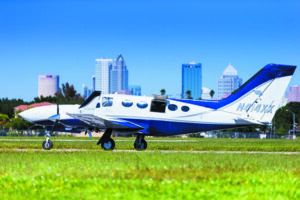
A potential buyer should carefully investigate the compliance status of the airplane by flight time and serial number, especially if the airplane is high time—and those that lived life on a charter certificate will have high time.
There are plenty of critical components that wear out. The exhaust system sees a great deal of heat and vibration, thus components wear out. An exhaust leak is a critical item on a turbocharged airplane and can lead to a serious fire in flight. (See the data report on page 25 for an abbreviated AD list.)
For previous reports on twin Cessnas, we spoke with Michael Cook and Todd Voshell, who direct maintenance at Rapid Air, in Grand Rapids, Michigan, which has been operating 300- and 400-series Cessna twins for many years. Both were quick to praise the 414 and especially the 414A as the best of the Cessna piston twins, with good systems, particularly the hydraulic gear on the 414A. They said that the Cessna inspection procedure manual for the airplane is one of the best such manuals written. If followed carefully, a mechanic won’t miss anything. Areas to watch on the pressurization system are to make sure the nine drain seals are changed regularly as they deteriorate and become brittle and to regularly check the pressurization ducts off of the heater, forward of the forward pressure bulkhead, as they can develop major leaks.
The exhaust system AD must be followed carefully, including the 30-day checks whether the airplane flies or not. The gear system of the 414A is easy to maintain, with one spot to watch: When assembling the center bolt on the main landing gear scissors, the correct washers must be installed in the correct sequence or the bolt can pull out, allowing the main gear wheel to turn sideways.
Boost pumps seem to be a weak point, requiring what seems to be frequent replacement. The deice light on the panel illuminates only very briefly when the pneumatic deicing system is activated and only indicates that there’s pressure to the tail boots. The switch for that light is on the underside of a T fitting in the pressure line to the tail and thus fills with water, rust and crud and should be pulled and cleaned periodically, or it will fail. It’s a $1000-plus component.
MODS AND TYPE CLUBS
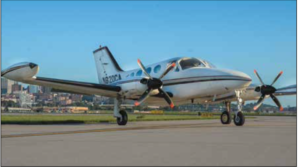
In our view, the Twin Cessna Flyer club (www.twincessna.org) is the hands-down go-to type club for the 414. It offers extensive and excellent support for the airplane, in addition to all other twin Cessnas. It’s an active organization and should be one of your top resources when buying a 414 or any Cessna twin.
Among the most popular mods are the RAM Aircraft Corporation engine swaps. Four variations are available, all of which offer a boost in useful load, increased TBOs and new props. The top of the line for the 414 is the series VII. In addition to 335-HP engines, new props and intercooler scoops, it includes a set of vortex generators and gives an increase in useful load of 415 pounds. Owners of 414As can opt for the series V conversion, which includes Continental’s 350-HP liquid-cooled Voyager engines, which have a TBO of 2000 hours. RAM also makes winglets and vortex generators. (See www.ramaircraft.com.)
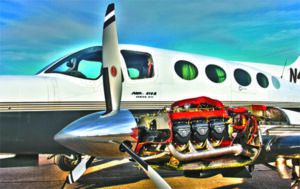
VGs are also available. A standout comes from Micro Aerodynamics (www.microaero.com) in Anacortes, Washington. By all accounts, vortex generators reduce Vmc and stall speeds. We highly recommend them. Micro Aerodynamics’ VGs provide a 350-pound gross-weight increase.
Speedbrakes/spoilers are available from PowerPac Spoilers (www.powerpacspoilers.com) and more advanced intercoolers come from American Aviation (www.americanaviationinc.com). There’s also the Speed Cover wheel mod from Premiere Aviation.
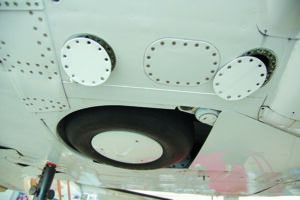
Skeptically, we tried the Speed Covers in a previous Aviation Consumer speed mod roundup article and verified the company’s claims of a 5- to 10-percent reduction in fuel burn and a single-engine climb rate increase of 25 percent. Contact the company at www.premiere-aviation.com.
FEEDBACK
We operated a 1977 Cessna 414 before stepping up to a Mitsubishi MU2. Before the 414, we had a Colemill 310N and found the 414 to be a much more versatile aircraft. The fuel burn in the low 30 GPH range combined for a solid 200-plus knots true airspeed at 18,000 to 20,000 feet.
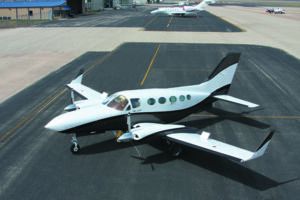
The aircraft’s sweet spot is in the low flight levels. Going up higher takes too long, the cabin altitude is too high and the engines just aren’t very happy. At FL190 there’s a 7500-foot cabin, which is comfortable even for long days. Block fuel burns compared to the 310 are higher, but not tremendously so on a long trip.
Our 414 held 203 gallons of fuel, which I considered to be essential if you want to make long trips non-stop. Making 1000-NM nonstop trips is routine for us in no-wind conditions (providing there is good weather). However, even 163 gallons of fuel will allow for a solid 600-NM block. Our mission involved a number of long legs, so we specifically sought out an aircraft that had over 203 gallons of fuel.
Although some tiptank-equipped birds have more complex systems than the 414A’s, the system is not inherently difficult to manage once you understand it. The system is effectively the same as a 310, so those making the upgrade won’t have any difficulties with the transition.
An additional benefit of the tiptank 414 versus the 414A is that it is smaller in overall length and width, meaning it can more easily fit into hangars. Plus, the purchase price for a 414 is significantly lower than an equivalent 414A. For us, these benefits were important.
The best improvement we made to the aircraft was the MT four-blade propellers. I consider this to be the single best improvement I’ve made on any aircraft. The upgrade saved 27 pounds and we notice a 100- to 200-FPM improvement in climb rate, as well as a 6- to 10-KTAS improvement in the low flight levels, while also being noticeably quieter than the old propellers they replaced.
The 414 is a stately aircraft—not the least bit sporty or nimble. It is not as fun to hand fly like a 310 is; however, it is easy to hand fly and very stable when shooting approaches. It’s extremely comfortable for long trips. Our missions frequently were in the range of 10 hours of flight time in one day, and the cockpit leaves enough room to stretch on those trips so that it remains comfortable. There’s lots of room for any portables, iPads or other items.
Many of the costs on the 414 are bipolar; either the big-dollar items need to be done or they don’t. Being pressurized, new windows (especially windshields) will get into the low $7000 range for parts and labor. Expect to pay in the low $5000 range if you need an engine beam, which unfortunately is not uncommon, especially if the shop performing the exhaust AD has not done a good job of finding issues when they come up. We had to replace an engine beam that had been damaged by an exhaust leak.
As for the overall airframe itself, we have found it to be reliable thus far, but we also started out with one that had lower time and had primarily been a Part 135 and corporate-operated aircraft.
The RAM upgrades on the 414 are of tremendous value, if for no other reason than the useful load. Without a RAM upgrade (ours was stock), useful load on a 414 is not very generous, and requires careful planning to stay within weight and CG limits. Weight reduction at any possible opportunity is worthwhile on this aircraft regardless of RAM status. We have managed to remove over 150 pounds from the aircraft—which is huge.
Ted DuPuis – via email
Not much has changed in the Cessna 414 market in the last 15 years, except that many of the aircraft now have glass panels, electronic engine management displays and other modern electronics.
The straight 414 (1970 to 1977) and the 414A Chancellor (1978 to 1985) continue to be appealing for buyers needing more than the six seats that a 340/340A offers. It is simply a bigger aircraft, especially for tall/heavy pilots and passengers. I have had big guys sit in the left seat of a 340 and then sit in the 414A cockpit and the decision is immediate. Passengers have the same reaction. For the buyer who absolutely does not want to own a geared-engine 421B/C, the 414/414A and 414AW (when winglets are installed)—which have a direct-drive Continental TSIO-520-NB—is the desired aircraft.
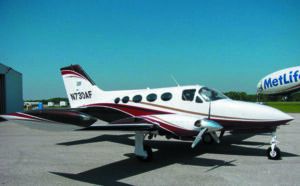
Present-day aircraft ownership issues are the critical shortage of hangars, the availability of insurance, required training and maintenance costs. Common maintenance issues involve the airworthiness of the windshield and cabin windows, plus the continued disagreements/disputes associated with interpretation of the exhaust system AD, issued back in January 2000.
And when it comes to sales issues, there is often a lack of knowledge by jet-model brokers not fully understanding and explaining what maintenance is required/optional for a high-performance piston twin that’s operating under Part 91.
The Cessna 400 series pressurized twins (414/414A, 421B/C) have relatively no competition. Some compare it to a Duke—but the cabin is no comparison.
For the 414 series, owner satisfaction is generally good, but it’s also worth a look at the 421. When selling twin Cessnas, I will hear comments like: “My 414A with winglets, RAM VI with VGs, spoilers and aft fuselage strakes is the best twin Cessna ever built,” and “My 421C with trailing-link gear, super-quiet and slow-turning 1800-RPM props, VGs, spoilers, aft fuselage strakes make it the best Cessna twin. Check the numbers.”
Jerry Temple – Jerry Temple Aviation
Our thanks to Craig Barnett at Scheme Designers, and the respected twin-Cessna sales pro, Jerry Temple, for helping with some of the photos and information in this report.

